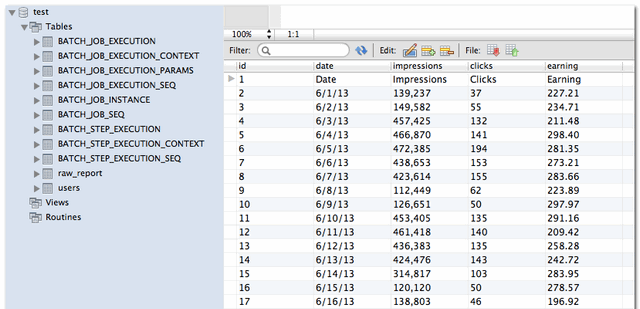Spring Batch Example – CSV File To MySQL Database
In this tutorial, we will show you how to configure a Spring Batch job to read data from a CSV file into a database.
Tools and libraries used :
Maven 3
Eclipse 4.2
JDK 1.6
Spring Core 3.2.2.RELEASE
Spring Batch 2.2.0.RELEASE
MySQL Java Driver 5.1.25
1. Java Project
Create a Java Project with Maven
$ mvn archetype:generate -DgroupId=com.mkyong -DartifactId=SpringBatchExample -DarchetypeArtifactId=maven-archetype-quickstart -DinteractiveMode=false
Convert to Eclipse project, and imports it into Eclipse IDE.
$ cd SpringBatchExample/ $ mvn eclipse:eclipse
2. Project Dependencies
Declares all project dependencies in pom.xml.
pom.xml
<project xmlns="http://maven.apache.org/POM/4.0.0"
xmlns:xsi="http://www.w3.org/2001/XMLSchema-instance"
xsi:schemaLocation="http://maven.apache.org/POM/4.0.0
http://maven.apache.org/maven-v4_0_0.xsd">
<modelVersion>4.0.0</modelVersion>
<groupId>com.mkyong</groupId>
<artifactId>SpringBatchExample</artifactId>
<packaging>jar</packaging>
<version>1.0-SNAPSHOT</version>
<name>SpringBatchExample</name>
<url>http://maven.apache.org</url>
<properties>
<jdk.version>1.6</jdk.version>
<spring.version>3.2.2.RELEASE</spring.version>
<spring.batch.version>2.2.0.RELEASE</spring.batch.version>
<mysql.driver.version>5.1.25</mysql.driver.version>
</properties>
<dependencies>
<!-- Spring Core -->
<dependency>
<groupId>org.springframework</groupId>
<artifactId>spring-core</artifactId>
<version>${spring.version}</version>
</dependency>
<!-- Spring jdbc, for database -->
<dependency>
<groupId>org.springframework</groupId>
<artifactId>spring-jdbc</artifactId>
<version>${spring.version}</version>
</dependency>
<!-- Spring Batch dependencies -->
<dependency>
<groupId>org.springframework.batch</groupId>
<artifactId>spring-batch-core</artifactId>
<version>${spring.batch.version}</version>
</dependency>
<dependency>
<groupId>org.springframework.batch</groupId>
<artifactId>spring-batch-infrastructure</artifactId>
<version>${spring.batch.version}</version>
</dependency>
<!-- MySQL database driver -->
<dependency>
<groupId>mysql</groupId>
<artifactId>mysql-connector-java</artifactId>
<version>${mysql.driver.version}</version>
</dependency>
</dependencies>
<build>
<finalName>spring-batch</finalName>
<plugins>
<plugin>
<groupId>org.apache.maven.plugins</groupId>
<artifactId>maven-eclipse-plugin</artifactId>
<version>2.9</version>
<configuration>
<downloadSources>true</downloadSources>
<downloadJavadocs>false</downloadJavadocs>
</configuration>
</plugin>
<plugin>
<groupId>org.apache.maven.plugins</groupId>
<artifactId>maven-compiler-plugin</artifactId>
<version>2.3.2</version>
<configuration>
<source>${jdk.version}</source>
<target>${jdk.version}</target>
</configuration>
</plugin>
</plugins>
</build>
</project>3. Project Directory Structure
Review the final project structure.

4. CSV File
This is the csv file in the resource folder.
report.csv
Date,Impressions,Clicks,Earning 6/1/13,"139,237",37,227.21 6/2/13,"149,582",55,234.71 6/3/13,"457,425",132,211.48 6/4/13,"466,870",141,298.40 6/5/13,"472,385",194,281.35 ......
5. MySQL Database
Defines a “dataSource” bean for MySQL database. The jdbc:initialize-database is used to create the metadata tables automatically, Spring Batch need it to store the job’s detail.
resources/spring/batch/config/database.xml
<beans xmlns="http://www.springframework.org/schema/beans" xmlns:jdbc="http://www.springframework.org/schema/jdbc" xmlns:xsi="http://www.w3.org/2001/XMLSchema-instance" xsi:schemaLocation="http://www.springframework.org/schema/beans http://www.springframework.org/schema/beans/spring-beans-3.2.xsd http://www.springframework.org/schema/jdbc http://www.springframework.org/schema/jdbc/spring-jdbc-3.2.xsd"> <!-- connect to database --> <bean id="dataSource" class="org.springframework.jdbc.datasource.DriverManagerDataSource"> <property name="driverClassName" value="com.mysql.jdbc.Driver" /> <property name="url" value="jdbc:mysql://localhost:3306/test" /> <property name="username" value="root" /> <property name="password" value="" /> </bean> <bean id="transactionManager" class="org.springframework.batch.support.transaction.ResourcelessTransactionManager" /> <!-- create job-meta tables automatically --> <jdbc:initialize-database data-source="dataSource"> <jdbc:script location="org/springframework/batch/core/schema-drop-mysql.sql" /> <jdbc:script location="org/springframework/batch/core/schema-mysql.sql" /> </jdbc:initialize-database> </beans>
6. Spring Batch Core Setting
Defines jobRepository and jobLauncher.
resources/spring/batch/config/context.xml
<beans xmlns="http://www.springframework.org/schema/beans" xmlns:xsi="http://www.w3.org/2001/XMLSchema-instance" xsi:schemaLocation=" http://www.springframework.org/schema/beans http://www.springframework.org/schema/beans/spring-beans-3.2.xsd"> <!-- stored job-metadata in database --> <bean id="jobRepository" class="org.springframework.batch.core.repository.support.JobRepositoryFactoryBean"> <property name="dataSource" ref="dataSource" /> <property name="transactionManager" ref="transactionManager" /> <property name="databaseType" value="mysql" /> </bean> <!-- stored job-metadata in memory --> <!-- <bean id="jobRepository" class="org.springframework.batch.core.repository.support.MapJobRepositoryFactoryBean"> <property name="transactionManager" ref="transactionManager" /> </bean> --> <bean id="jobLauncher" class="org.springframework.batch.core.launch.support.SimpleJobLauncher"> <property name="jobRepository" ref="jobRepository" /> </bean> </beans>
7. Spring Batch Jobs
This is the main xml file to configure the Spring batch job. This job-report.xml file define a job to read a report.csv file, match it to report plain pojo and write the data into MySQL database.
Read the comment, it should be self-explanatory. Btw, remember create the “RAW_REPORT” table manually.
resources/spring/batch/jobs/job-report.xml
<beans xmlns="http://www.springframework.org/schema/beans" xmlns:batch="http://www.springframework.org/schema/batch" xmlns:task="http://www.springframework.org/schema/task" xmlns:xsi="http://www.w3.org/2001/XMLSchema-instance" xsi:schemaLocation="http://www.springframework.org/schema/batch http://www.springframework.org/schema/batch/spring-batch-2.2.xsd http://www.springframework.org/schema/beans http://www.springframework.org/schema/beans/spring-beans-3.2.xsd"> <bean id="report" class="com.mkyong.model.Report" scope="prototype" /> <batch:job id="reportJob"> <batch:step id="step1"> <batch:tasklet> <batch:chunk reader="cvsFileItemReader" writer="mysqlItemWriter" commit-interval="2"> </batch:chunk> </batch:tasklet> </batch:step> </batch:job> <bean id="cvsFileItemReader" class="org.springframework.batch.item.file.FlatFileItemReader"> <!-- Read a csv file --> <property name="resource" value="classpath:cvs/report.csv" /> <property name="lineMapper"> <bean class="org.springframework.batch.item.file.mapping.DefaultLineMapper"> <!-- split it --> <property name="lineTokenizer"> <bean class="org.springframework.batch.item.file.transform.DelimitedLineTokenizer"> <property name="names" value="date,impressions,clicks,earning" /> </bean> </property> <property name="fieldSetMapper"> <!-- return back to reader, rather than a mapped object. --> <!-- <bean class="org.springframework.batch.item.file.mapping.PassThroughFieldSetMapper" /> --> <!-- map to an object --> <bean class="org.springframework.batch.item.file.mapping.BeanWrapperFieldSetMapper"> <property name="prototypeBeanName" value="report" /> </bean> </property> </bean> </property> </bean> <bean id="mysqlItemWriter" class="org.springframework.batch.item.database.JdbcBatchItemWriter"> <property name="dataSource" ref="dataSource" /> <property name="sql"> <value> <![CDATA[ insert into RAW_REPORT(DATE,IMPRESSIONS,CLICKS,EARNING) values (:date, :impressions, :clicks, :earning) ]]> </value> </property> <!-- It will take care matching between object property and sql name parameter --> <property name="itemSqlParameterSourceProvider"> <bean class="org.springframework.batch.item.database.BeanPropertyItemSqlParameterSourceProvider" /> </property> </bean> </beans>
com/mkyong/model/Report.java
package com.mkyong.model;
public class Report {
private String Date;
private String Impressions;
private String Clicks;
private String Earning;
//getter and setter methodsNote
For detail explanation, please refer to this Spring batch references.
8. Run It
Loads everything and run it jobLauncher. This is the simplest way to start and test it, but, in real life, you may need to launch it with scheduler frameworks like Spring task, Quartz or system scheduler like “cron” command (I will show you in coming tutorials).
com/mkyong/App.java
package com.mkyong;
import org.springframework.batch.core.Job;
import org.springframework.batch.core.JobExecution;
import org.springframework.batch.core.JobParameters;
import org.springframework.batch.core.launch.JobLauncher;
import org.springframework.context.ApplicationContext;
import org.springframework.context.support.ClassPathXmlApplicationContext;
public class App {
public static void main(String[] args) {
String[] springConfig =
{ "spring/batch/config/database.xml",
"spring/batch/config/context.xml",
"spring/batch/jobs/job-report.xml"
};
ApplicationContext context =
new ClassPathXmlApplicationContext(springConfig);
JobLauncher jobLauncher = (JobLauncher) context.getBean("jobLauncher");
Job job = (Job) context.getBean("reportJob");
try {
JobExecution execution = jobLauncher.run(job, new JobParameters());
System.out.println("Exit Status : " + execution.getStatus());
} catch (Exception e) {
e.printStackTrace();
System.out.println("Done");Output. The Spring Batch metadata tables are created, and the content of report.cvs is inserted into database table “RAW_REPORT“.

Done.
References
From:一号门

COMMENTS